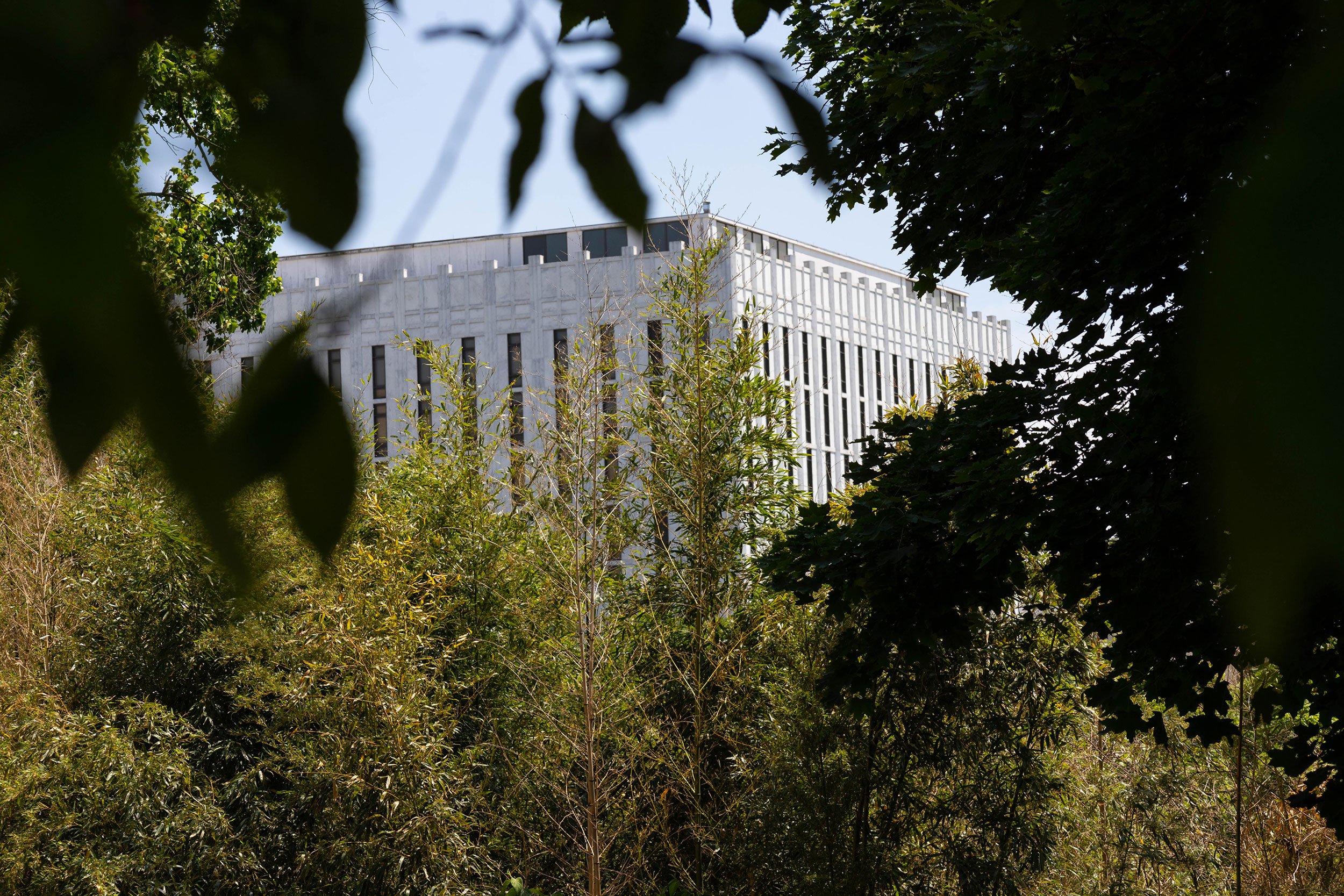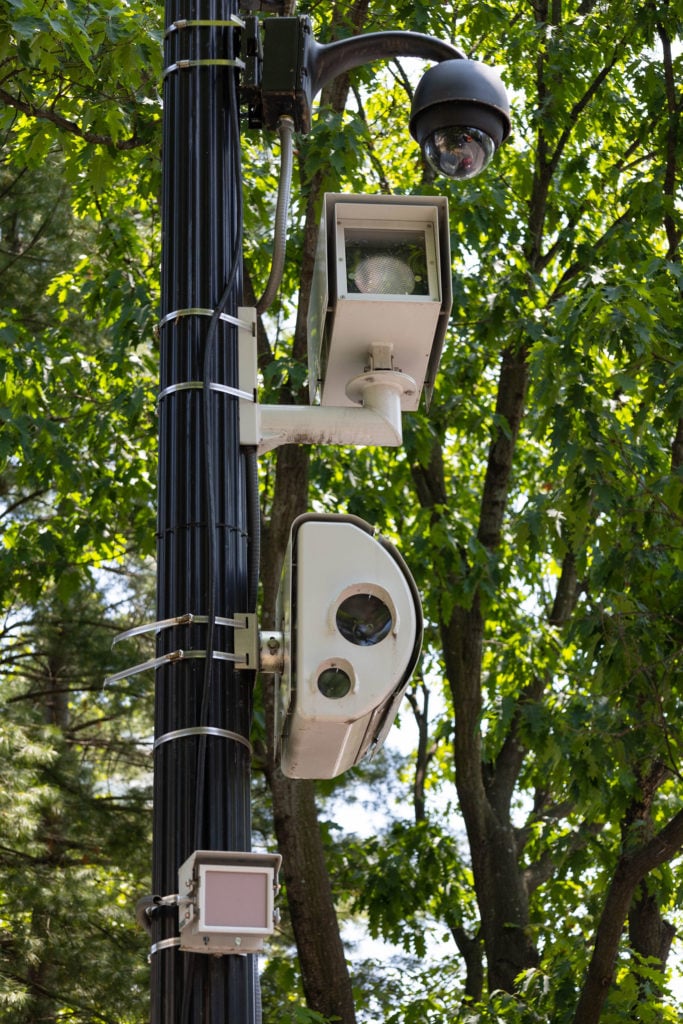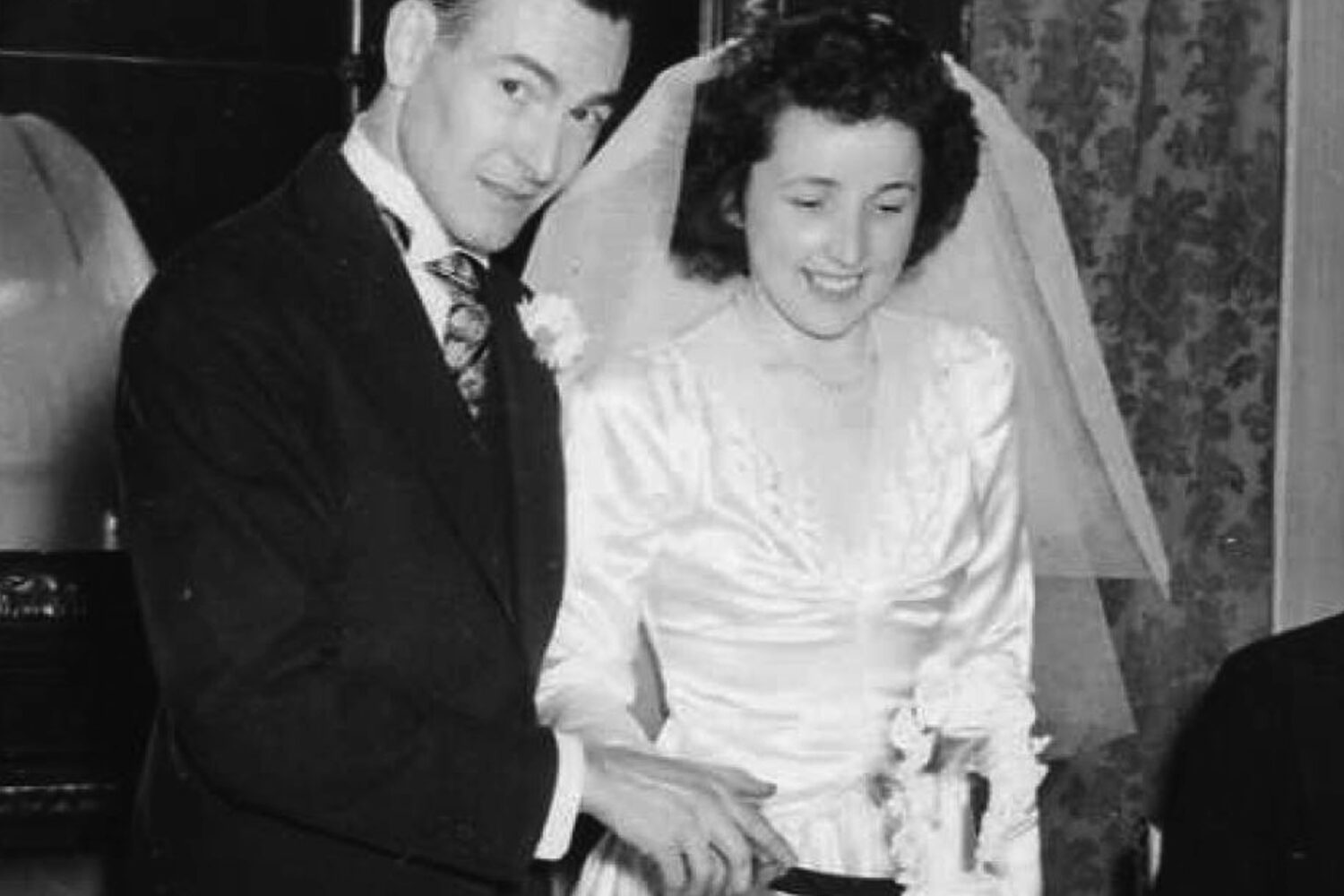In the mid-1980s, at a rundown group house on upper Wisconsin Avenue, a woman named Monica heard a knock at her door. On her porch, she found two men claiming to be FBI agents. They asked if they could tune their listening devices from her attic.
Gobsmacked, Monica looked them over. These men were clean-cut, nondescript, middle-aged—plausibly FBI. But how could she know for sure? She took down their information and sent them away. After all, they could be murderers or rapists. Or they could be Soviet spies from the brand-new embassy compound across the street.
When Monica called the bureau about the men at her doorstep, nobody would confirm who they were. Nonetheless, she got the impression that it would be good to invite them back. The agents arrived “dressed like dads” (windbreakers, jeans, sneakers), hauling electronic equipment disguised as groceries. These “groceries,” they said, were devices for eavesdropping on the Soviets, which they used while circling the embassy compound in vans. Up they went to her attic, bags in tow. Then they left and never came back.
A couple years later, the FBI turned up again, this time at the house next door. After decades as a family home, the property became a rental—and the new tenants struck the neighbors as strange. Seven days a week, teams of men rotated in and out of the house at eight-hour intervals, almost as if they were working in shifts. Often, these men hauled large bags of Kodak film, which was probably for the cameras—the ones that could sometimes be glimpsed through the house’s tinted windows, but only when the sun hit just right. Those cameras were mounted on tripods, pointed at the embassy across the street.
From roughly 1990 through 2013, neighbors say that 2619 Wisconsin Avenue was a “spy house”: an observation and listening post disguised as a residence. The FBI, of course, won’t comment, but many of the locals will. For decades, the blocks surrounding the Russian Embassy have been abuzz with odd stories: a secret tunnel mouth for espionage, garages with blacked-out windows, unexplained interference on phone calls, and a mysterious rooftop antenna array. Yes, this sounds like conspiracy theory—but most of it is probably true.
If you strolled past the Russian Embassy, in the upper reaches of Glover Park, you might not notice the house. It’s a red-brick Colonial with straw-colored trim that blends in with the rest of the block. Nothing about it stands out, except maybe the windows—the three dark ones set into the roof. It’s hard to say why they’re conspicuous, though skylights don’t normally face the street.
The spy house’s owner is Michael Massino; his grandfather built it around 1935. On the phone, he’s terse and careful, insisting that he “won’t talk about anything about the house.” True to his word, he doesn’t divulge much. This excerpt will give you a taste:
Why is it that you can’t talk about your house?
“I like my privacy. I’m prudent.”
Was there a tenant living there between 1990 and 2013?
“There was a tenant.”
Can you say anything else about that?
“Nope.”
Is it true that your house was a surveillance post?
“I have no comment on it. People say a lot of different things.”
While Massino is tight-lipped about the property, a half dozen neighbors are not. Their stories are consistent: Each day at 8 am, a team of agents would arrive at the house. These were typically men, they wore jackets and button-downs, and they drove dark, unmarked sedans. Another team replaced them at 4 pm, then a third at midnight. The men didn’t small-talk, and they never discussed who they were.
Neighbors say the house was overt. “It wasn’t like [the FBI] was trying to keep it secret. For years, it was full-tilt knowledge.”
At the house, the shades were always drawn and the lights stayed off. Nobody was ever in the yard, and the garbage bins rarely went out. “My sister would go over there all the time wanting to borrow sugar, just to irritate them,” says Kevin McDuffie, who lived one house down, “but they’d sort of look out the blinds and not ever answer the door.”
Typically, the spy house kept a low profile, but occasionally it made a splash on the block. In 2001, for instance, McDuffie says he was at work when he got word that a man had broken into his house. He rushed home to find military vehicles parked up and down Wisconsin, which seemed excessive, since the burglar was just an older guy, disoriented from drugs. “People were like, ‘Are you an ambassador? Are you diplomatic corps?’ ” says McDuffie, who is a real-estate agent. “Then I found out that my neighbors had called it in.”
As for hard proof of the spy house, Jim Popkin got about as close as it comes. In the late aughts, Popkin—then a reporter at NBC—was running on Wisconsin Avenue when the setting sun hit the house’s tinted skylights, revealing a camera that couldn’t ordinarily be seen. Intrigued, he ran the address through a database at work, and a name popped up as a resident. The man’s listed occupation? “Clerk really a spy.”
Popkin figures the guy wrote it as a joke—on a washing-machine warranty or magazine subscription—not realizing that “clerk really a spy” would get sucked into a database and follow him around. But it’s basically the truth: The man turned out to be an FBI surveillance specialist. When Popkin got him on the phone, he was not thrilled to be speaking with a reporter, but he didn’t deny that he’d worked at that house. The FBI didn’t confirm or deny it either, though it asked Popkin not to print the specific address.
Despite the bureau’s reticence, neighbors say the house was pretty overt. “It wasn’t like [the FBI] was trying to keep it secret,” McDuffie says. “For years, it was full-tilt knowledge. The whole neighborhood knew.” Wary of crossing the feds, most neighbors request anonymity to discuss the spy house. They also seem delighted to recall it. “I just love the spy-versus-spy stuff that happens quietly throughout Washington,” Popkin says, “including very close to where you live.”
If the neighbors knew about the spy house, then the Russians certainly did, too. Apparently, that’s standard practice; the FBI watches the Russians, and the Russians know they’re being watched. But what, specifically, were they looking for, these workers who showed up every day? Washingtonian called a few espionage experts to find out.
In the game of counterintelligence, as it’s played across the globe, you must watch your adversary’s embassy. You put eyes on all entrances and exits—24 hours a day, seven days a week, even on holidays, even when you’re short on personnel. Every face and license plate is photographed. The time of each entrance and egress is logged. Day after day, you create copious and meticulous records. When someone gets sloppy, you hope it’s the other side’s people, not yours.
Much of what you’ll see is mundane: diplomats coming to work, diplomats leaving to conduct diplomatic business, citizens applying for visas or passports, officials arriving for diplomatic events. But often, things are not as they seem. Many “diplomats” are actually undercover intelligence officers. You’ll never learn who unless you watch.

And there’s another reason to watch an embassy: to see if your own people show up. If a CIA officer knocks on the Russians’ door, maybe there’s a legitimate purpose, but it also might be treason—to sell the specs of our surveillance satellites or the identities of our agents abroad. Woe to the G-man who missed this disloyalty for a snack break. It’s a mistake that could cost billions of dollars, not to mention lives.
In addition to watching, the house was probably listening—fishing around for electronic signals from which foreign secrets might be gleaned. “There’s phenomena all around the embassy that need to be picked up,” says Andrew Hammond, a historian at the International Spy Museum: radio chatter, phone calls, machine transmissions. To collect them, agents with gadgets probably lurked in the house across the street.
While the FBI wouldn’t have eavesdropped on the locals, neighbors sometimes felt the effects. Around the embassy, there’s talk of electronic interference on phone calls and patchy TV reception. Then there was the incident with the garage door. When Bill Brownfield first moved to the street behind the spy house, his next-door neighbor told him something odd: For months, his garage door would open and close, unprovoked, at all hours of the day and night. The neighbor developed a theory that emanations between the embassy and the spy house were somehow triggering his electronic opener. Finally, he mentioned the issue to the guys at shift change. Apparently, it never happened again.
James Olson, the CIA’s former director of counterintelligence, says the neighbor’s theory checks out. “Garage doors open by electronic signal,” he says, “and when the FBI and the Russian Embassy are in the area, there are going to be a lot of electronic signals going back and forth.” In fact, he thinks most of the neighbors’ observations make sense. Classified trash is typically incinerated, for instance, so of course no one was hauling bins to the curb. And the FBI often eavesdrops in vans rigged with listening devices, which periodically need to be tuned.
During the Cold War, Olson himself was the target of a spy house—a spy apartment, actually. At the time, he worked “for the State Department” (wink wink) at the US Embassy in Moscow, but his real job was with the CIA. At the enormous residential building where he and other foreign diplomats lived, the activity on one floor was conspicuous. “Every morning, we would see a lot of [Russian] workers going up to the fourth floor with big reels of tape under their arm,” he says. “They didn’t make any bones about it. It was quite obvious that was their [listening post].”
Because of the eavesdropping, Olson had to be scrupulously careful; he couldn’t talk about his work or his personal problems, even in the privacy of his home. “I was blanketed by KGB surveillance,” he recalls, “and it was very stifling. Very oppressive. Very threatening.” To live that way takes discipline. It can drive people nuts. And that’s another reason to have a spy house: to cause pervasive psychological stress, which might lead an intelligence officer to make mistakes.
Speaking of mistakes, when planning the Russian Embassy, the US made some doozies. The first was the site itself: the second-highest hill in DC. From a counterintelligence perspective, “high on a hill” is not where you want your enemy to be.
Embassies are intelligence-gathering platforms, and one thing they’re collecting is waves: electronic communications, machine chatter—“signals intelligence,” in the parlance of spies. Most of these waves can’t travel through buildings or mountains, but they sail right through the air. This means that if you can see a target, you can potentially collect signals from it—and from the top of a hill, much can be seen.
“Just think about it—the capital of the United States, all of those agencies, all of America’s global commitments,” says Hammond, the historian from the Spy Museum. “Imagine the amount of communication that’s necessary to keep all of those systems running.” The opportunities for signals collection are astonishing: the White House, the Capitol, the State Department, and the Pentagon—all of which are said to be visible from the Russian Embassy’s roof.
In the late 1960s, when the State Department offered the Soviets their current site, the US intelligence community went ballistic. Our primary geopolitical adversary had been handed a significant strategic advantage, and to counter it the FBI needed to be ambitious. That’s how the tunnel began. The idea was bold: In partnership with the NSA, the FBI would burrow under the embassy in an elaborate effort to snoop. Reportedly, this set taxpayers back several hundred million dollars—at least triple the cost of the entire Soviet compound.
But from the beginning, the operation was a bust. The tunnel periodically flooded, and the NSA’s surveillance equipment didn’t quite work as planned. (Reportedly, one issue was with laser beams shot into the embassy from below, which proved somewhat difficult to wield.) Another blow came from Robert Hanssen, an FBI agent who was secretly spying for Russia and tipped off his handlers to the scheme. For years, the tunnel apparently produced no worthwhile intelligence. Eventually, the FBI says it gave up and cemented over the mouth.
Until 2001, when Hanssen was arrested for espionage, the existence of the tunnel was secret, but his capture revealed the bungled operation to the world. It also surfaced a piquant detail: The tunnel evidently originated inside a nearby residential home, though the FBI didn’t specify which one.
This caused a sensation in Glover Park. Somehow, the bureau had covertly requisitioned a house in a tight-knit residential neighborhood and dug a tunnel from its basement. How did it hide the noise? Or secretly cart off the dirt? Immediately, the spy house became a focus. “Everybody speculated it was from [there],” Kevin McDuffie recalls. “I had all these people knocking on my door a lot—not just local reporters, but national reporters for NBC and ABC.”
To this day, guessing the location of the tunnel mouth remains a parlor game on the block. Some believe it’s beneath a recently torn-down house by the embassy’s back fence; others say it’s inside a blocked-off storage unit in the basement of a condo building on Tunlaw Road. Many people still think the mouth is in the spy house. Michael Massino says it’s not. Though he often hedges when speaking about his house, the tunnel mouth is the only rumor he explicitly denies.
While the aura of mystery lingers, the spy house no longer hosts spies. Toward the end of 2013, Bill Brownfield stopped seeing the shift changes. Around that time, McDuffie says the Massino family asked him to make discreet inquiries about selling the house and its adjoining vacant lot.
Together, the house and lot were an attractive parcel for development—there was talk of a homeless shelter, then a facility for senior living—which caused some of the neighbors great angst. “People were digging for any logical reason for why this would be a bad idea,” Brownfield says, and one anti-development scheme took root: If the spy house were given historic-landmark status, it couldn’t be torn down. But its historic nature—its alleged surveillance mission—has still never been officially acknowledged, and to apply on those grounds required proof.
In search of it, neighbors recruited someone to make inquiries: a senior government official who lives in a nearby house. This man, who asked not to be named, sniffed around various agencies to see if anyone might help. He said it was “like pulling teeth.” Then, after a couple months, came a response from a government official, essentially saying that while he couldn’t confirm that the property had ever been used for surveillance, he could unofficially say that the federal government was no longer interested in the house. It wasn’t enough for the historic-landmark application, but it seemed to confirm the local hunch: that the FBI had moved on.

Where to? Well, obviously the bureau won’t say. But Jim Popkin points to clusters of cameras on telephone poles ringing the embassy—black globes that almost look like lamps. He’s counted 41 of them in total, blanketing the surrounding blocks. It’s possible the technology got so good that the FBI no longer needs humans to sit across the street and watch.
As for the signals collection, Bill Brownfield has a theory: On the roof of an apartment building just up the street from the embassy, there’s a “phenomenal array of electronic equipment—I mean antennas coming out of the wazoo.” Next to them is a “little structure that is kind of enclosed” that Brownfield speculates may house “particularly sensitive kinds of electronic equipment.” But he acknowledges he’ll probably never know. “I bet you’ll never get any human being in the world—unless it’s a Russian speaker—to tell you where the team went.”
These days, the spy house is still standing; no development plans have yet come through. But the exterior has been transformed—the lights are on, the yard is covered in anti-Putin signs, and the porch is draped with blue-and-yellow flags. Instead of spying on the Russians, the house now seems bent on rankling them. Massino and his neighbors are loudly pro-Ukraine.
Offered the opportunity to correct any misinformation about his house, Michael Massino declines. “I’m just very cautious about talking to the media,” he says. McDuffie, who lived next door for two decades, thinks Massino may have signed an NDA. But it’s possible things will change. Asked if there’s anything he wants to add, Massino is cryptic: “In ten years, we can talk again.”
This article appears in the July 2023 issue of Washingtonian.








